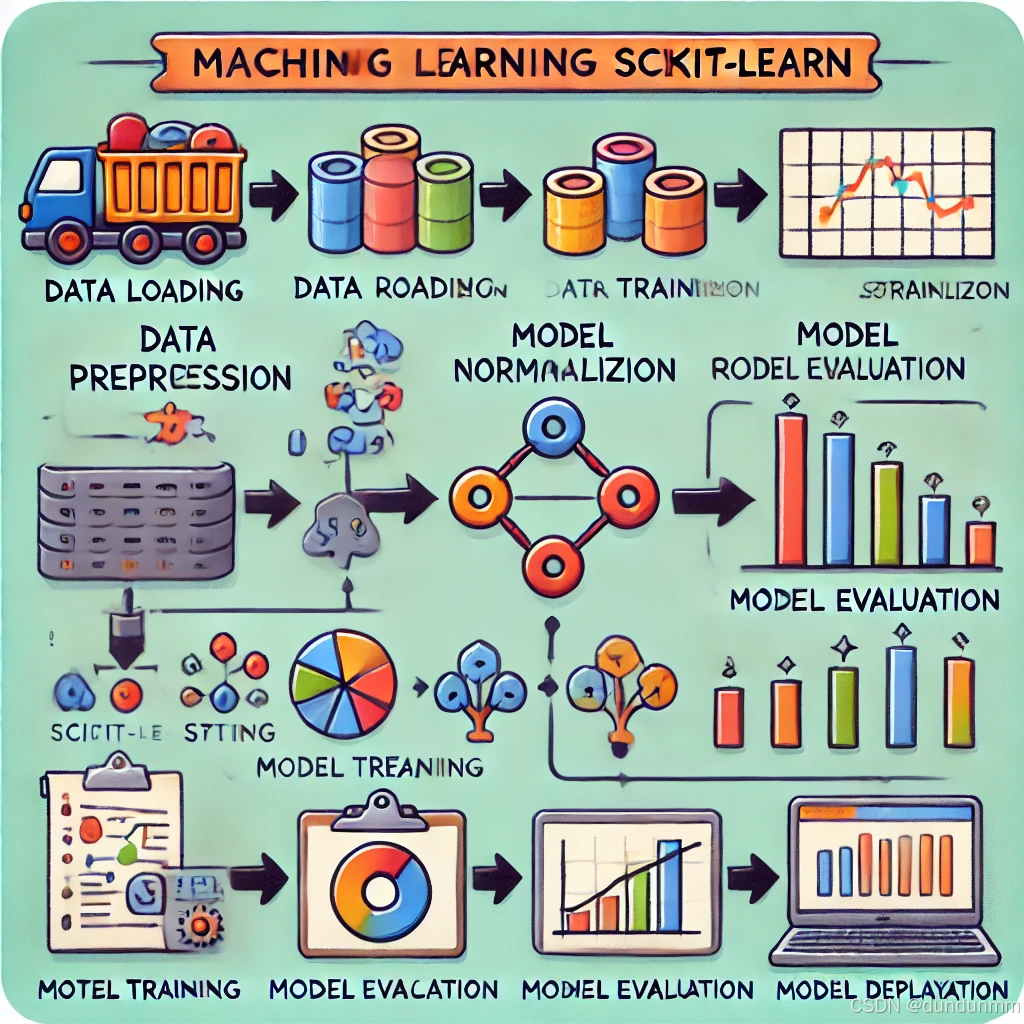scikit-learn(简称 sklearn)是 Python 生态中一个非常流行且强大的机器学习库,支持各种机器学习算法和工具。
核心模块和功能
-
监督学习 (Supervised Learning):
-
分类 (Classification):
-
支持的算法:KNN、SVM、决策树、随机森林、Logistic回归、朴素贝叶斯等。
-
示例:
from sklearn.ensemble import RandomForestClassifier clf = RandomForestClassifier(n_estimators=100, random_state=42) clf.fit(X_train, y_train) # 训练模型 predictions = clf.predict(X_test) # 预测
-
-
回归 (Regression):
-
支持的算法:线性回归、Ridge回归、Lasso回归、SVR等。
-
示例:
from sklearn.linear_model import LinearRegression reg = LinearRegression() reg.fit(X_train, y_train) # 拟合数据 predictions = reg.predict(X_test) # 预测
-
-
-
无监督学习 (Unsupervised Learning):
-
聚类 (Clustering):
-
支持的算法:K-Means、DBSCAN、层次聚类等。
-
示例:
from sklearn.cluster import KMeans kmeans = KMeans(n_clusters=3, random_state=42) kmeans.fit(X) # 拟合数据 labels = kmeans.labels_ # 获取聚类标签
-
-
降维 (Dimensionality Reduction):
-
支持的算法:PCA、TSNE、ICA等。
-
示例:
from sklearn.decomposition import PCA pca = PCA(n_components=2) X_reduced = pca.fit_transform(X) # 降维
-
-
-
模型选择与优化 (Model Selection and Optimization):
-
交叉验证 (Cross Validation):
-
使用
cross_val_score实现简单交叉验证。 -
示例:
from sklearn.model_selection import cross_val_score scores = cross_val_score(clf, X, y, cv=5) # 5折交叉验证 print(scores.mean()) # 平均准确率
-
-
超参数调优 (Hyperparameter Tuning):
-
使用
GridSearchCV或RandomizedSearchCV。 -
示例:
from sklearn.model_selection import GridSearchCV param_grid = {'n_estimators': [50, 100, 150], 'max_depth': [10, 20, None]} grid_search = GridSearchCV(RandomForestClassifier(), param_grid, cv=3) grid_search.fit(X_train, y_train) print(grid_search.best_params_) # 最优参数
-
-
-
预处理 (Preprocessing):
-
标准化与归一化:
-
使用
StandardScaler或MinMaxScaler。 -
示例:
from sklearn.preprocessing import StandardScaler scaler = StandardScaler() X_scaled = scaler.fit_transform(X)
-
-
特征选择 (Feature Selection):
-
支持的方法:SelectKBest、递归特征消除 (RFE) 等。
-
示例:
from sklearn.feature_selection import SelectKBest, f_classif selector = SelectKBest(f_classif, k=10) X_new = selector.fit_transform(X, y)
-
-
常用工具
-
评估指标 (Metrics):
-
分类指标:准确率、F1分数、ROC曲线等。
from sklearn.metrics import accuracy_score, classification_report print(accuracy_score(y_test, y_pred)) print(classification_report(y_test, y_pred)) -
回归指标:均方误差 (MSE)、R²等。
from sklearn.metrics import mean_squared_error, r2_score print(mean_squared_error(y_test, y_pred)) print(r2_score(y_test, y_pred))
-
-
数据集工具:
-
自带数据集加载:如
iris、digits等。from sklearn.datasets import load_iris data = load_iris() X, y = data.data, data.target -
数据集拆分:
from sklearn.model_selection import train_test_split X_train, X_test, y_train, y_test = train_test_split(X, y, test_size=0.2, random_state=42)
-
完整工作流程示例
以一个分类任务为例,使用随机森林进行训练并评估:
from sklearn.datasets import load_iris
from sklearn.model_selection import train_test_split
from sklearn.ensemble import RandomForestClassifier
from sklearn.metrics import accuracy_score, classification_report
# 1. 加载数据
data = load_iris()
X, y = data.data, data.target
# 2. 数据集划分
X_train, X_test, y_train, y_test = train_test_split(X, y, test_size=0.2, random_state=42)
# 3. 模型训练
clf = RandomForestClassifier(n_estimators=100, random_state=42)
clf.fit(X_train, y_train)
# 4. 模型预测
y_pred = clf.predict(X_test)
# 5. 模型评估
print("Accuracy:", accuracy_score(y_test, y_pred))
print(classification_report(y_test, y_pred))适用场景
- 快速实现基于传统方法的机器学习任务。
- 教学或研究中算法的对比实验。
- 中小型数据集的机器学习应用。
